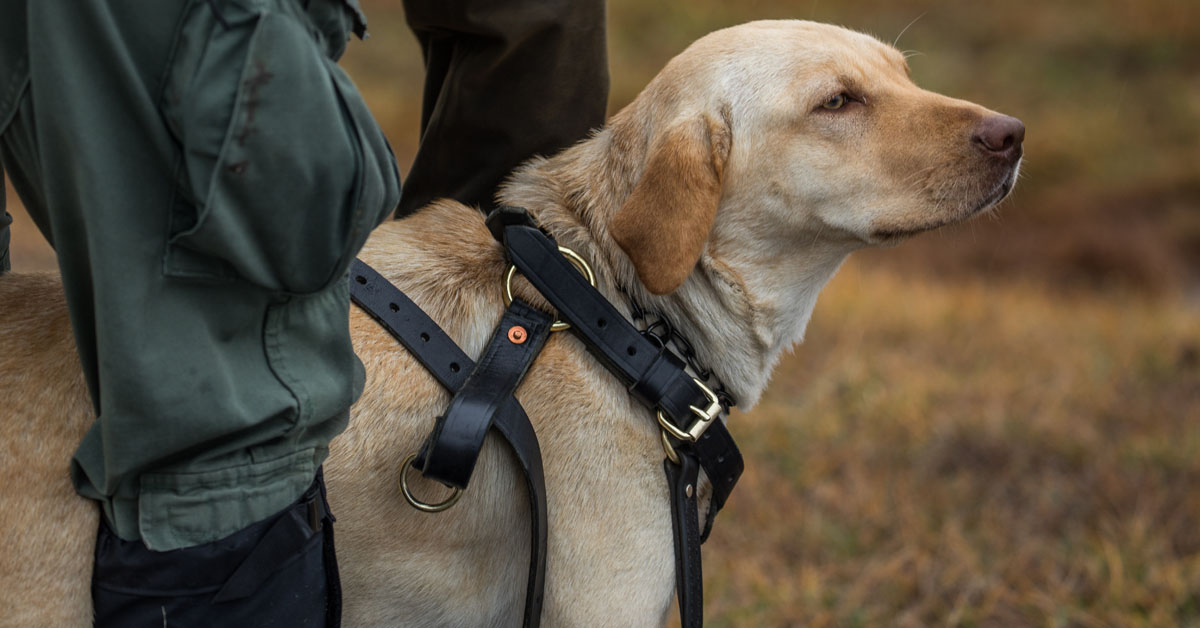
K9 Lily waits patiently as her tracking harness is put on.
By Molly Kirk
Photos by Meghan Marchetti
If you’ve been following along with the five dogs in training to become K9 Conservation Police Officers with the Virginia Department of Wildlife Resources (DWR), you may have noticed the harness that the dogs wear when tracking. It’s a special piece of equipment that not only serves practical purposes, but also acts as a cue for the dog. In fact, as they learn to be K9 CPOs, the dogs learn that different collars signal different roles for them.
The five trainee pairs had two weeks off from intensive training as they worked on basic obedience at home for the past two weeks, but as of Monday, March 9, they’re back at “school,” working on article tracking skills. The DWR K9 program is supported by the Ward Burton Wildlife Foundation (WBWF). You can help by donating to the Caring for the CPO K9s Fund through WBWF. Your donation will go to veterinary care, maintenance costs, and training for the K9 CPOs
The basic collar that each dog in the K9 program wears is a chain choke collar. The handlers mostly use the stationary ring of the collar when leading the dog, and sometimes the active ring when corrections might be needed. The collar slides on and off easily over the dog’s head.
Each handler also has a 15-foot long leather lead. Leather is easier on the handler’s hands, and doesn’t pick up briars or thorns when navigating in the woods and brush. The 15-foot length gives the dog freedom to follow a tracking line. When a handler has a dog out of the truck, he usually has the lead attached to the choke collar.
But when the dog and handler are about to start tracking, the handler brings the tracking harness out of the truck. Made of leather and very adjustable, the tracking harness transfers the pressure of the lead to be spread over the dog’s chest rather than on its neck. This allows the handler to keep a consistent, light contact with the dog while they’re tracking. “With the harness, we never give any lead corrections,” said Senior CPO Richard Howald, a veteran K9 handler with DWR who is leading the current training sessions. “You never pull hard on the harness.”
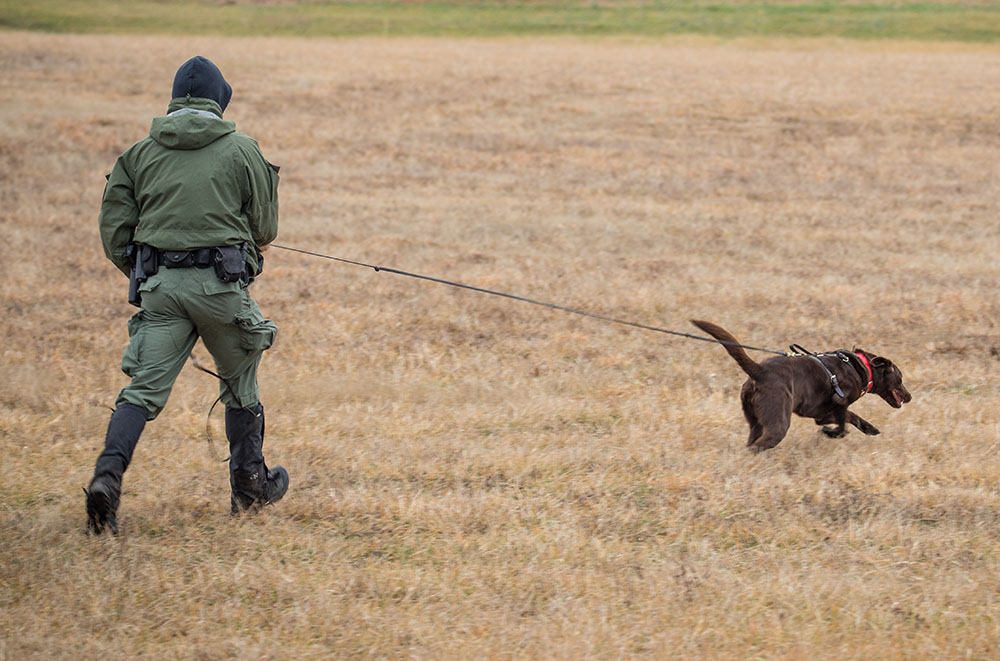
The 15-foot leather lead keeps the handler in touch with the dog, but allows the dog freedom to find and follow a track.
There’s a specific process that handlers follow in putting the harness on the dog. Each handler has his or her own version, but basically they bring the dog to where they’ll start tracking, put the tracking harness on, clip the lead to the harness, and remove the choke collar from the dog. Then they give a verbal command to “track.” “They’ll hold onto the dog with their legs while they switch from collar to harness, because as soon as you let that dog go, he wants to run,” said Howald. “If you have your legs securing just in front of their hips, it keeps them from taking off. That way, when you’re switching collars and harness, your dog doesn’t get away from you and is safe.”
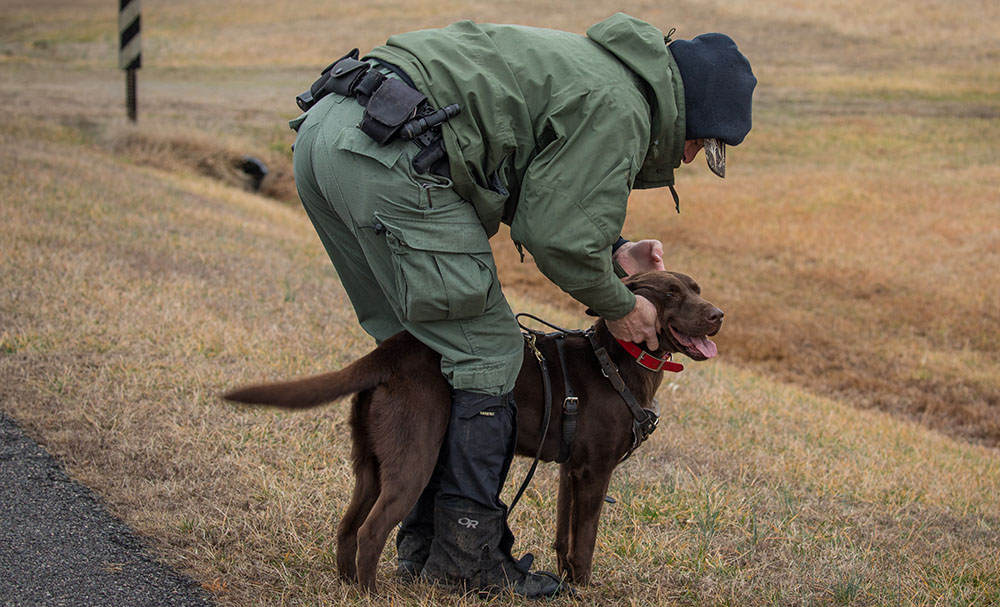
Senior CPO Wes Billings removes Molly’s choke collar after putting her tracking harness on and clipping the lead to the harness. Molly is also wearing her GPS collar.
Howald noted that as the process is repeated again and again, the dogs learn that the harness going on and the choke collar coming off means they’re going to be turned loose to track. “When you take the collar off, you can see the tail will start wagging really hard,” he said. “They think, ‘That choker is off, and I can go wherever I want.’ You do that enough times, and when they see that harness come out of the truck, they know what they’re going to do.”
When the dog has found what he or she was tracking, the harness is immediately removed before the dog is rewarded with play. As this routine is repeated, the dog learns to associate the harness with the job of tracking.
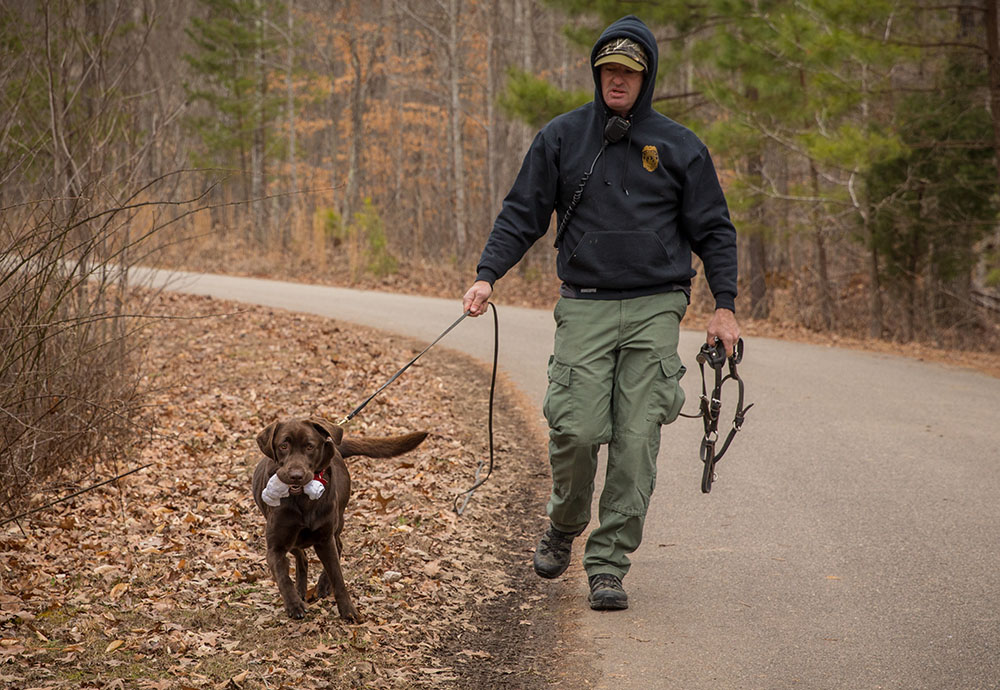
Senior CPO Wes Billings and Molly return from a tracking exercise. Billings removed Molly’s tracking harness after she completed the exercise, and put her choke collar back on.
Another useful piece of equipment for the K9s is the GPS collar. Again, each handler uses it differently, but many of them keep the GPS collar on the dog at all times that the dog is working. “When we put that dog in the truck in the morning, we put their GPS collar on,” Howald said. “That’s telling that dog, ‘We’re working now.’ When they get home at the end of the day, we take that GPS collar off and tell the dog, ‘All done,’ and the dog knows he’s done for the day and can go just be a dog.”
The GPS collars for the five new K9 trainees were generously donated to the program by the Ashland, Virginia, location of Bass Pro Shops.
In the course of a day’s work, the GPS collar has many uses. If by chance a dog gets away from his or her handler, the handler can locate him or her by GPS signal. The GPS collars also have lights on them, to make the dogs more visible in the dark if needed. “All our dogs’ collars can be programmed into one GPS handheld device, so if I am working with another dog and handler on a scene and they’re already out working, I can see where they are,” said Howald. “If I’m working with other officers, I can hand them the GPS and they can follow along with where the dog and I are, and possibly set a perimeter. If I find evidence, they can mark where that evidence is and send a team in to retrieve it.”
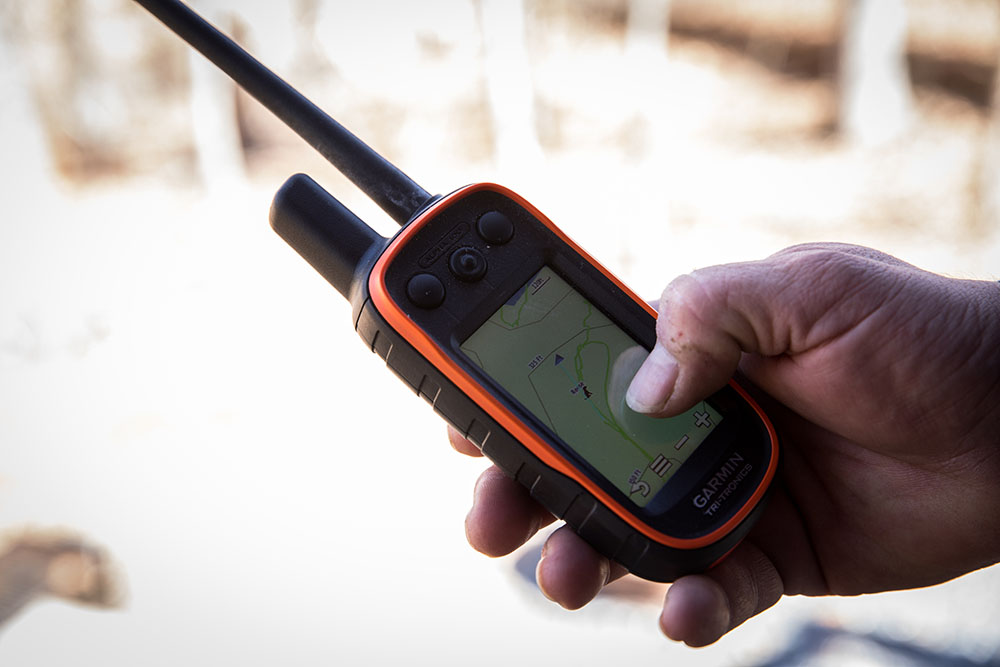
With the handheld GPS units, CPOs can see where a K9 is tracking and mark important locations.
During tracking training, Howald can map the scent line that someone laid on the GPS, then watch the dog’s GPS signal to see if the dog is tracking the right line. “We also use the GPS for documentation with our KANINE SIX program, which is a performance management software that aids handlers and management in evaluating the effectiveness of the dogs. We plug the collar into the computer and it will download time, temperature, distance, how long the dog worked, and a map with the track. It’s a lot more than a collar!”
The K9s and handlers started another three-week session of training on March 9, moving on to working on article searches. Read more about the K9 training program and DWR’s K9 CPO program, including an introduction to the dogs and descriptions of their first three weeks of training.
Do you want to support the K9s as they continue to learn? Donate to the Caring for the CPO K9s Fund through the Ward Burton Wildlife Foundation to help them achieve their goals and to protect Virginia’s people and wildlife.
Donate


